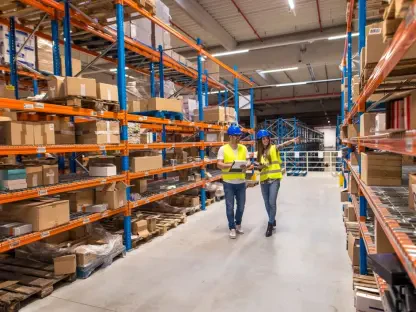The cross-border logistics market has become a crucial component of global trade, facilitating the seamless movement of goods, materials, and products across international borders. This intricate network of transportation, customs procedures, and logistics management processes has seen significant evolution, fueled by technological advancements and the rapidly expanding e-commerce sector. This article delves into the multifaceted landscape of cross-border logistics, analyzing trends, drivers, opportunities, and challenges.
The Dynamic Landscape of Cross-Border Logistics
Technological Innovations Driving Efficiency
In recent years, the integration of advanced technologies like big data, artificial intelligence (AI), and the Internet of Things (IoT) has revolutionized the logistics industry. These technologies enable companies to streamline supply chain operations, enhance visibility, and reduce overall costs. AI is instrumental in route optimization, predictive maintenance, and demand forecasting, while IoT devices provide real-time tracking and monitoring of shipments. This combination results in a significant boost to the operational efficiencies and cost-effectiveness of logistics services.
Companies are increasingly adopting Logistics Platform as a Service (LPaaS) and Software as a Service (SaaS) models to enhance their operational capabilities. These platforms facilitate better coordination among various stakeholders, from manufacturers to end consumers, ensuring that goods are delivered efficiently and on time. Blockchain technology is also making inroads, providing secure and transparent documentation processes that mitigate the risk of fraud and streamline customs clearance. This technological synergy aids businesses in navigating the complexities of cross-border trade with higher precision and reliability.
Impact of E-Commerce on Cross-Border Logistics
The exponential growth of e-commerce has been a cornerstone driver for the cross-border logistics market. Online shopping and digital marketplaces demand fast and reliable shipping solutions, which in turn propels logistics companies to innovate and expand their service offerings. Retailers are increasingly relying on logistics providers to manage warehousing, inventory, and last-mile delivery, ensuring a seamless shopping experience for customers across the globe. The rise in cross-border online purchases has necessitated an evolution in logistics strategies to keep pace with consumer expectations.
To cater to the burgeoning e-commerce sector, logistics companies are investing in automation and robotics. Automated warehouses and fulfillment centers enable faster order processing and accurate inventory management, while robotic solutions like autonomous delivery vehicles and drones are being explored to further expedite delivery times. The emphasis on speed and efficiency is paramount as e-commerce continues to shape the logistics landscape. These innovations are not just enhancing operational efficiencies but also significantly improving customer satisfaction by reducing delivery times and errors.
Market Drivers and Opportunities
Globalization and Trade
Globalization has significantly influenced the cross-border logistics market, driving increased demand for international transportation and delivery services. As businesses expand their operations worldwide, the need for robust and reliable logistics solutions has become more pronounced. Companies must navigate a complex web of international trade laws, tariffs, and regulations to ensure the smooth flow of goods across borders. This growing interconnectedness means that logistics providers play a critical role in facilitating seamless global trade.
Emerging markets in regions like Asia-Pacific, South America, and Africa present substantial growth opportunities for logistics providers. Developing economies are witnessing rapid industrialization and urbanization, leading to increased trade volumes and the need for efficient logistics infrastructure. Companies that can establish a strong presence in these regions stand to gain a competitive edge. By focusing on these markets, logistics providers can capitalize on the untapped potential and address the rising demand for efficient cross-border logistics services.
Innovations and Strategic Partnerships
Leading logistics companies like Aramex, FedEx, and COYOTE are at the forefront of innovation, investing heavily in research and development to bring new solutions to the market. These companies are forming strategic partnerships with technology firms, startups, and other industry players to enhance their service offerings and expand their geographical reach. The collaboration with tech companies is particularly crucial as it allows logistics providers to integrate cutting-edge technologies into their operations seamlessly.
Collaborations between logistics providers and e-commerce platforms are becoming increasingly common, as both sectors seek to optimize their supply chain operations. By leveraging each other’s strengths, these partnerships can offer end-to-end logistics solutions that cater to the specific needs of online retailers and their customers. Acquisitions and mergers are also prevalent, with companies seeking to consolidate their market presence and enhance their service capabilities. This strategic approach not only broadens their service offerings but also bolsters their market position in a highly competitive landscape.
Challenges in the Cross-Border Logistics Market
Navigating Regulatory Complexities
One of the most significant challenges in cross-border logistics is navigating the complexities of international trade regulations. Each country has its own set of customs requirements, tariffs, and compliance standards, making it challenging for logistics providers to ensure smooth operations. Companies must invest in robust compliance systems and stay updated on regulatory changes to avoid disruptions and delays. Staying compliant with these diverse regulations requires meticulous planning and the adoption of sophisticated compliance management tools.
Trade policies and geopolitical factors also play a crucial role in shaping the logistics landscape. Changes in trade agreements, tariffs, and border controls can have far-reaching implications for cross-border logistics operations. Companies must adopt agile strategies and closely monitor geopolitical developments to mitigate risks and adapt to changing conditions. By remaining adaptable, logistics providers can anticipate and swiftly respond to regulatory shifts, thereby maintaining operational continuity and efficiency.
Infrastructure and Cost Management
While technological advancements are driving efficiencies in logistics operations, inadequate infrastructure in certain regions can pose significant challenges. Poorly developed transportation networks, limited warehousing facilities, and unreliable utilities can hinder the smooth flow of goods. Logistics providers must invest in infrastructure development and collaborate with local authorities to overcome these hurdles. Enhancing infrastructure not only facilitates smoother operations but also reduces transit times and operational bottlenecks.
Cost management remains a critical concern for logistics companies, as they strive to balance operational efficiency with service quality. Rising fuel costs, labor expenses, and maintenance overheads can impact profitability. Companies must explore innovative solutions like fuel-efficient transportation modes, alternative energy sources, and predictive maintenance to manage costs effectively. By implementing these strategies, logistics firms can ensure sustainable operations while maintaining the high service standards required by their clients.
Future Outlook and Strategic Approaches
Embracing Technological Advancements
The cross-border logistics market has become indispensable to global trade, enabling the smooth movement of goods, materials, and products across international borders. This complex web of transportation, customs procedures, and logistics management has significantly evolved, driven by technological advancements and the surging e-commerce sector. Advances like real-time tracking, blockchain for secure transactions, and automated customs clearance have streamlined these processes.
One key trend is the growing reliance on digital platforms for better supply chain visibility and efficiency. Companies now leverage data analytics and AI to optimize routes and reduce costs. Additionally, the rise of e-commerce has increased demand for faster and more reliable shipping services. However, businesses face challenges, including regulatory disparities and geopolitical tensions that can disrupt the flow of goods.
Opportunities abound for companies that can navigate these complexities, such as expanding into new markets and adopting innovative technologies. Overall, the cross-border logistics landscape is a dynamic and essential facet of today’s global economy, offering various opportunities and challenges.









